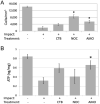Complementary models reveal cellular responses to contact stresses that contribute to post-traumatic osteoarthritis
- PMID: 27509320
- PMCID: PMC5303196
- DOI: 10.1002/jor.23389
Complementary models reveal cellular responses to contact stresses that contribute to post-traumatic osteoarthritis
Abstract
Two categories of joint overloading cause post-traumatic osteoarthritis (PTOA): single acute traumatic loads/impactions and repetitive overloading due to incongruity/instability. We developed and refined three classes of complementary models to define relationships between joint overloading and progressive cartilage loss across the spectrum of acute injuries and chronic joint abnormalities: explant and whole joint models that allow probing of cellular responses to mechanical injury and contact stresses, animal models that enable study of PTOA pathways in living joints and pre-clinical testing of treatments, and patient-specific computational models that define the overloading that causes OA in humans. We coordinated methodologies across models so that results from each informed the others, maximizing the benefit of this complementary approach. We are incorporating results from these investigations into biomathematical models to provide predictions of PTOA risk and guide treatment. Each approach has limitations, but each provides opportunities to elucidate PTOA pathogenesis. Taken together, they help define levels of joint overloading that cause cartilage destruction, show that both forms of overloading can act through the same biologic pathways, and create a framework for initiating clinical interventions that decrease PTOA risk. Considered collectively, studies extending from explants to humans show that thresholds of joint overloading that cause cartilage loss can be defined, that to at least some extent both forms of joint overloading act through the same biologic pathways, and interventions that interrupt these pathways prevent cartilage damage. These observations suggest that treatments that decrease the risk of all forms of OA progression can be discovered. © 2016 Orthopaedic Research Society. Published by Wiley Periodicals, Inc. J Orthop Res 35:515-523, 2017.
Keywords: animal models; chondrocytes; computational models; joint trauma; post-traumatic osteoarthritis.
© 2016 Orthopaedic Research Society. Published by Wiley Periodicals, Inc.
Figures





Similar articles
-
Using mouse models to investigate the pathophysiology, treatment, and prevention of post-traumatic osteoarthritis.J Orthop Res. 2017 Mar;35(3):424-439. doi: 10.1002/jor.23343. Epub 2016 Jun 28. J Orthop Res. 2017. PMID: 27312470 Review.
-
Mathematics as a conduit for translational research in post-traumatic osteoarthritis.J Orthop Res. 2017 Mar;35(3):566-572. doi: 10.1002/jor.23439. Epub 2016 Oct 3. J Orthop Res. 2017. PMID: 27653021 Free PMC article.
-
Use of pre-clinical surgically induced models to understand biomechanical and biological consequences of PTOA development.J Orthop Res. 2017 Mar;35(3):454-465. doi: 10.1002/jor.23322. Epub 2017 Mar 2. J Orthop Res. 2017. PMID: 27256202 Review.
-
Inflammation in joint injury and post-traumatic osteoarthritis.Osteoarthritis Cartilage. 2015 Nov;23(11):1825-34. doi: 10.1016/j.joca.2015.08.015. Osteoarthritis Cartilage. 2015. PMID: 26521728 Free PMC article. Review.
-
Intra-articular dexamethasone to inhibit the development of post-traumatic osteoarthritis.J Orthop Res. 2017 Mar;35(3):406-411. doi: 10.1002/jor.23295. Epub 2017 Mar 2. J Orthop Res. 2017. PMID: 27176565 Free PMC article. Review.
Cited by
-
Articular cartilage gene expression patterns in the tissue surrounding the impact site following applications of shear and axial loads.BMC Musculoskelet Disord. 2018 Dec 22;19(1):449. doi: 10.1186/s12891-018-2374-2. BMC Musculoskelet Disord. 2018. PMID: 30579353 Free PMC article.
-
An Integrated View of Stressors as Causative Agents in OA Pathogenesis.Biomolecules. 2023 Apr 22;13(5):721. doi: 10.3390/biom13050721. Biomolecules. 2023. PMID: 37238590 Free PMC article. Review.
-
Acute Changes in NADPH Oxidase 4 in Early Post-Traumatic Osteoarthritis.J Orthop Res. 2019 Nov;37(11):2429-2436. doi: 10.1002/jor.24417. Epub 2019 Aug 1. J Orthop Res. 2019. PMID: 31304988 Free PMC article.
-
Biomechanical Response to External Biofeedback During Functional Tasks in Individuals With Chronic Ankle Instability.J Athl Train. 2021 Mar 1;56(3):263-271. doi: 10.4085/197-20. Epub 2021 Feb 18. J Athl Train. 2021. PMID: 33150445 Free PMC article.
-
HPLC-UV Method Validation for Amobarbital and Pharmaceutical Stability Evaluation When Dispersed in a Hyaluronic Acid Hydrogel: A New Concept for Post-Traumatic Osteoarthritis Prevention.J Pharm Sci. 2022 May;111(5):1379-1390. doi: 10.1016/j.xphs.2021.09.025. Epub 2021 Sep 23. J Pharm Sci. 2022. PMID: 34563533 Free PMC article.
References
-
- Buckwalter JA, Mankin HJ, Grodzinsky AJ. Articular cartilage and osteoarthritis. Instr Course Lect. 2005;54:465–480. - PubMed
-
- Cross JD, Ficke JR, Hsu JR, Masini BD, Wenke JC. Battlefield orthopaedic injuries cause the majority of long-term disabilities. J Am Acad Orthop Surg. 2011;19(1):S1–7. - PubMed
-
- Buckwalter JA, Brown TD. Joint injury, repair, and remodeling: roles in post-traumatic osteoarthritis. Clin Orthop Relat Res. 2004;423:7–16. - PubMed
Publication types
MeSH terms
Grants and funding
LinkOut - more resources
Full Text Sources
Other Literature Sources
Medical

